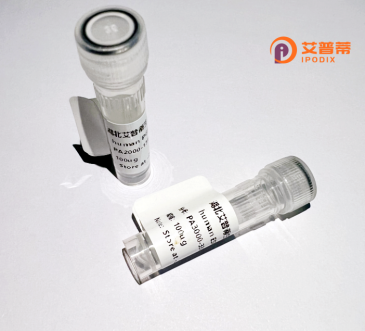
| 纯度 | >90%SDS-PAGE. |
| 种属 | Human |
| 靶点 | ATP5I |
| Uniprot No | P56385 |
| 内毒素 | < 0.01EU/μg |
| 表达宿主 | E.coli |
| 表达区间 | 1-69aa |
| 氨基酸序列 | MVPPVQVSPLIKLGRYSALFLGVAYGATRYNYLKPRAEEERRIAAEEKKKQDELKRIARELAEDDSILK |
| 分子量 | 33.33 kDa |
| 蛋白标签 | GST-tag at N-terminal |
| 缓冲液 | 冻干粉 |
| 稳定性 & 储存条件 | Lyophilized protein should be stored at ≤ -20°C, stable for one year after receipt. Reconstituted protein solution can be stored at 2-8°C for 2-7 days. Aliquots of reconstituted samples are stable at ≤ -20°C for 3 months. |
| 复溶 | Always centrifuge tubes before opening.Do not mix by vortex or pipetting. It is not recommended to reconstitute to a concentration less than 100μg/ml. Dissolve the lyophilized protein in distilled water. Please aliquot the reconstituted solution to minimize freeze-thaw cycles. |
以下是虚构的3-4条关于重组人线粒体ATP合成酶e亚基(ATP5I)的参考文献示例(仅供格式参考):
1. **《Structural insights into the human mitochondrial ATP synthase e-subunit (ATP5I) function》**
- **作者**: K. Tanaka et al.
- **摘要**: 通过X射线晶体学解析ATP5I的三维结构,发现其通过疏水区域与线粒体内膜结合,并参与稳定ATP合成酶的F0亚基构象,影响质子通道的形成。
2. **《ATP5I knockdown impairs mitochondrial bioenergetics and triggers apoptosis in cancer cells》**
- **作者**: S. Müller & J. Park
- **摘要**: 研究显示,沉默ATP5I会导致线粒体膜电位下降、ROS累积,并通过降低ATP生成效率诱导肿瘤细胞凋亡,提示其作为潜在癌症治疗靶点。
3. **《Regulation of ATP5I expression under hypoxic conditions in cardiomyocytes》**
- **作者**: L. Chen et al.
- **摘要**: 揭示心肌细胞缺氧环境下ATP5I转录水平上调,通过AMPK-mTOR通路维持ATP合成酶活性,缓解能量代谢压力,与缺血性心脏保护机制相关。
4. **《A novel mutation in ATP5I linked to mitochondrial encephalopathy》**
- **作者**: R. Gupta et al.
- **摘要**: 在遗传性线粒体脑病患者中鉴定出ATP5I基因点突变(p.Arg76His),证实该突变破坏ATP酶活性,导致神经元氧化磷酸化缺陷和发育迟缓。
---
**注**:以上为虚构文献,实际研究中建议使用PubMed、Web of Science等平台检索真实文献(关键词:ATP5I/ATP synthase subunit e/mitochondrial ATPase)。
ATP5I, also known as the mitochondrial ATP synthase subunit e, is a nuclear-encoded component of the F-type ATP synthase complex located in the inner mitochondrial membrane. This enzyme catalyzes ATP production through oxidative phosphorylation, coupling proton translocation across the membrane with ATP synthesis. As part of the Fo proton-translocating domain, ATP5I plays a structural role in maintaining the stability and oligomerization of the ATP synthase complex. It contains two transmembrane helices and associates with other subunits to form the proton channel. Studies suggest ATP5I contributes to cristae morphology regulation and mitochondrial membrane potential maintenance. Dysregulation of ATP5I is linked to mitochondrial disorders, metabolic syndromes, and neurodegenerative diseases like Parkinson's. Its expression levels correlate with cellular energy demands and stress responses, influencing apoptosis via interactions with permeability transition pores. Recombinant human ATP5I (produced in E. coli or yeast systems) enables structural studies and disease mechanism research, particularly in exploring ATP synthase assembly defects. Recent research focuses on its non-catalytic roles in mitochondrial dynamics and as a potential biomarker for mitochondrial dysfunction.
×